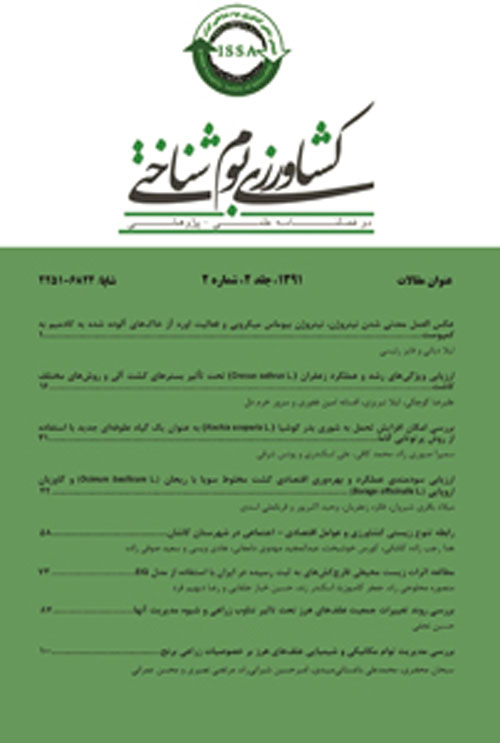Potential of stale seed bed technique in weed management of winter oilseed rapeseed (Brassica napus L.) fields
Author(s):
Abstract:
Introduction
Rapeseed cultivation is considered important and the area under its cultivation is on the rise. Weeds commonly occur in rapeseed fields and their infestation is a major yield reducing factor. Weeds with branched, vigorous root systems inhibit the development of rapeseed plants through severe nutrition deprivation (Roshdy et al., 2008). Usually, rapeseed weed management is done with using mechanical, chemical, and biological methods and the combination of these methods increases the weed control efficiency. A combination of a stale seedbed technique with chemical and mechanical methods in rapeseed cultivation can be an efficient method, because the stale seedbed allows weeds to germinate in straw or a cultivated field and can then destroy them by tillage or herbicide before planting rapeseed. The purpose of this research was to evaluate the effect of the combination of cultural weed control with mechanical and chemical methods for the weed control of rapeseed.Materials And Methods
This study was conducted during the 2008 and 2009 growing seasons at Safiabad of Dezfol and Darab of Fars. The experimental design was a randomized complete blocks with a split-plot arrangement with 12 treatments and three replications. The main factor comprised a weed control method at six levels, including: 1- pre-planting irrigation mechanical weed control, 2- pre-planting irrigation Treflan (Trifluralin EC48%) at 2lit ha-1 pre-planting and soil incorporated Galantsuper (Haloxyfop R methyl Ester EC10.8%) at 0.75lit ha-1 post-emergence, 3- pre-planting irrigation Gramoxone (Paraquat SL20%) 3lit ha-1 post-emergence, 4- Treflan at 2lit ha-1 pre-planting and soil incorporated Galantsuper 0.75lit ha-1 postemergence, 5- Weedy check and 6- Weed-free check. The sub-plot contained a sowing date at two levels, including: an early sowing date and a Late sowing date.Results And Discussion
Results of the experiments showed that, in Darab, the early sowing date was the best date for sowing rapeseed while, in Safiabad, the sowing date had no effect on weed control and yield. In Darab at the early sowing date, pre-planting irrigation mechanical weed control (2145 kg ha-1) and pre-planting irrigation Gramoxone (1875 kg ha-1) were the best treatments for rapeseed yield. Weed control also showed the same trend. In Safiabad, rapeseed yield in pre-planting irrigation treatments (mean 2300 kg ha-1), herbicide treatment (2128 kg ha-1), without weed control treatment (2242 kg ha-1) and weed control treatment (2634 kg ha1) had no significant difference. Weed control for most of weeds showed the same trend.Conclusion
Hence, it seems that planting rapeseed in proper time can give rapeseed a competitive power through the development of a broad canopy and shade over weeds in the early stages of the weeds, so that it is not even necessary to control weeds. However, when rapeseed cannot compete with weeds, a combination of stale seedbed with chemical and mechanical methods at the proper planting time is efficient. Rapeseed plant traits are associated with competitiveness and allelopathy (Asaduzzaman et al., 2011) and competitive ability is evaluated by the ability of plant morphological traits to improve access to scarce light, nutrients and water in a limited space (Asaduzzaman et al., 2014). Language:
Persian
Published:
Journal of Agroecology, Volume:6 Issue: 2, 2017
Page:
245
https://magiran.com/p1680996


